
The first Vallejo Flour Mill, in present-day Fremont, California, was built in 1853 by José de Jesús Vallejo (1798–1882), elder brother of General Mariano Guadalupe Vallejo, on his Rancho Arroyo de la Alameda. The Flour Mill was located at the mouth of Niles Canyon, then called Alameda Cañon, which served as the major course of Alameda Creek. A second Flour Mill was built in 1856, the stone foundation of which may still be seen today.

The Wilcox, Crittenden Mill, also known as Wilcox, Crittenden Mill Historic District, is a 17-acre (6.9 ha) property in Middletown, Connecticut that was listed on the National Register of Historic Places in 1986. It was the location of the Wilcox, Crittenden company, a marine hardware firm. The historic district listing included four contributing buildings and three other contributing sites.

The White Building, also known as the Heberling Building, is located in the city of Bloomington, Illinois, United States. Located along Bloomington's East Douglas Street, the building was added to the National Register of Historic Places in June 1994 and represents one of the better examples of Commercial style architecture still extant in the city. It was built by Bloomington resident Samuel R. White in 1894–1895 to house his furniture sales company. By 1903 the Heberling Brothers pharmacy and their associated businesses occupied most of the building and the White company had moved its facilities to a nearby location. The White Building is a five-story red brick building which is elaborately windowed and has a three-story connected extension to its west which probably predates it.

The Sheridan Flouring Mills, also known as the Mill Inn, are an industrial complex in Sheridan, Wyoming. The mills were a major component of the economy of north central Wyoming, providing collection, storage and milling of locally produced wheat and other grains into flour and other milled products. The original mill was established by Captain Scott W. Snively in the early 1890s. The Sheridan Milling and Manufacturing Company was sold to J.W. Denio in 1903, who operated the mill at its location on Broadway Avenue near downtown Sheridan. A catastrophic fire destroyed this mill in 1919, resulting in the purchase of a new location on Coffeen Avenue and construction of a much larger mill.

George Washington's Gristmill was part of the original Mount Vernon plantation, constructed during the lifetime of the United States' first president. The original structure was destroyed about 1850. The Commonwealth of Virginia and the Mount Vernon Ladies’ Association have reconstructed the gristmill and the adjacent distillery. The reconstructed buildings are located at their original site three miles (5 km) west of Mount Vernon proper near Woodlawn Plantation in Alexandria, Virginia. Because the reconstructed buildings embody the distinctive characteristics of late eighteenth century methods of production and are of importance to the history of Virginia, the site is listed on the National Register of Historic Places despite the fact that the buildings are not original.

The Masonic Temple in downtown Casper, Wyoming is a Masonic hall, built in 1914 during a boom time initiated by the development of the Salt Creek Oil Field. Located on a corner site, the temple remains essentially as it was designed by Casper architect Homer F. Shaffer. The four story light-colored brick building rests on a raised basement and is topped by a crenelated parapet. The original windows have been replaced with vinyl units but retain the one-over-one appearance of the originals. Windows extend over the west and south sides. The north side is blank, while the east side is the building's rear facade and has fire escapes and a few windows.

The Calumet and Hecla Industrial District is a historic district located in Calumet, Michigan and roughly bounded by Hecla & Torch Lake Railroad tracks, Calumet Avenue, Mine and Depot Streets. The district contains structures associated with the copper mines worked by the Calumet and Hecla Mining Company, located along a line above the copper lode, where railroad tracks connected separate mine heads. The Historic District is completely contained in the Calumet Historic District and the Keweenaw National Historical Park. It was designated a Michigan State Historic Site in 1973 and was listed on the National Register of Historic Places in 1974.

The Crescent Warehouse Historic District is a 10.5-acre (4.2 ha) historic district in Downtown Davenport, Iowa, United States. The district is a collection of multi-story brick structures that formerly housed warehouses and factories. Most of the buildings have been converted into loft apartments. The district was listed on the National Register of Historic Places in 2003.

The Uinta County Courthouse in Evanston, Wyoming is the oldest courthouse building in Wyoming, and one of the oldest permanent structures in Wyoming. Built in three stages, the first phase was a two-story jail, built in 1873. It was expanded with court facilities the following year, and in 1910 the main portion of the Georgian Revival structure was built with the present façade. Each phase showed an increasing attention to detail and ornament.

Smith Warehouse is a historic tobacco storage warehouse located at Durham, Durham County, North Carolina. It was built in 1906, and is a two-story Romanesque style brick structure divided into 12 70-foot-wide units by projecting corbeled firewalls. The building measures 850 feet long and 100 feet wide and features ornamental brickwork. It is an example of "slow burn" masonry and wood factory construction. It was the last of the 12 brick tobacco storage warehouses erected by The American Tobacco Company trust beginning in 1897. The building has been converted to residential use.

Acme-McCrary Hosiery Mills, also known as Acme Hosiery Mills, McCrary Hosiery Mills, and Asheboro Grocery Company, is a historic textile mill complex located at Asheboro, Randolph County, North Carolina. The complex includes six buildings and a smokestack, erected between 1909 and 1962. The mill buildings were designed by architect Richard C. Biberstein and the oldest section is a two-story, heavy-timber-frame mill with load bearing brick walls. The Acme-McCrary-Sapona Recreation Center was built in 1948–1949, and is a two-story, Art Moderne style brick recreation center. The buildings were added to the National Register of Historic Places in 2014.

Storey Gymnasium, also known as Cheyenne High School Gymnasium, was built in 1950 on the campus of Central High School in Cheyenne, Wyoming, United States. The brick gymnasium was designed by Cheyenne architect Frederic Hutchinson Porter to include additional functions associated with the school's ROTC program, with an armory, rifle range and drill halls in addition to classrooms, shops and music spaces. The contractor was Loren Hancock, who built it at a cost of $646,611.66. It was named for William Storey, a member of the school Board of Trustees. When East High School was built in 1965 the facility was shared between East and Central.

The Cheyenne High School at 2810 House Avenue in Cheyenne, Wyoming is a Late Gothic Revival-style building which was built in 1921. It has also been known as Central High School and as Laramie County School District No.1 Administration Building and was listed on the National Register of Historic Places in 2005.

Wyoming Fuel Company, an Early Commercial-style warehouse at 720 W. 18th St. in Cheyenne, Wyoming, was built in 1929, with an addition added in 1937. It was listed on the National Register of Historic Places in 2003.
The Brigham City Co-op was one of the most successful cooperative enterprises of the Mormons in Utah.

The Continental Oil Company building complex is a significant component of railroad-related economic activity in Cheyenne, Wyoming. Built beginning in 1905, the complex was used by the Continental Oil Company for bulk oil storage through much of the 20th century. The property was transferred to the Sioux Oil Company, which vacated the complex in 1990. In 2000 the property was occupied by a trailer sales business.

The McCord-Brady Company, at 1506 Thomes Ave. in Cheyenne, Wyoming, was built in 1914–15. It was listed on the National Register of Historic Places in 2003. It has also been known as Asher-Wyoming Company Wholesale Grocers and as Cheyenne Winlectric Company.

The Laramie County Milk Producers Cooperative Association, at 1122 W. 23rd St. in Cheyenne, Wyoming, was built in 1923. It was listed on the National Register of Historic Places in 2003.

The Henderson Block, at 375 W. 200 South in Salt Lake City, Utah was designed by architect Walter E. Ware and was built in 1897–98. It was listed on the National Register of Historic Places in 1978. It was also included as a contributing building in the Warehouse District.

The Warren Motor Car Company Building, also known as Lincoln Motor Car Company Building, is a factory located at 1331 Holden Street in Detroit, Michigan. It was listed on the National Register of Historic Places in 2020.



















